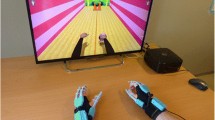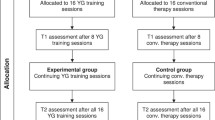Abstract
Stroke is the leading cause of serious, long-term disability in the United States. Impairment of upper extremity function is a common outcome following stroke, often to the detriment of lifestyle and employment opportunities. While the upper extremity is a natural target for therapy, treatment may be hampered by limitations in baseline capability as lack of success may discourage arm and hand use. We developeda virtual reality (VR) system in order to encourage repetitive task practice. This system combined an assistive glove with a novel VR environment. A set of exercises for this system was developed to encourage specific movements. Six stroke survivors with chronic upper extremity hemiparesis volunteered to participate in a pilot study in which they completed 18 one-hour training sessions with the VR system. Performance with the system was recorded across the 18 training sessions. Clinical evaluations of motor control were conducted at three time points: prior to initiation of training, following the end of training, and 1 month later. Subjects displayed significant improvement on performance of the virtual tasks over the course of the training, although for the clinical outcome measures only lateral pinch showed significant improvement. Future expansion to multi-user virtual environments may extend the benefits of this system for stroke survivors with hemiparesis by furthering engagement in the rehabilitation exercises.






Similar content being viewed by others
Abbreviations
- 3D:
-
Three-dimensional
- ARAT:
-
Action research arm test
- BBT:
-
Box and blocks test
- CMSA_A:
-
Chedoke-McMaster stroke assessment, stage of arm
- CMSA_H:
-
Chedoke-McMaster stroke assessment, stage of hand
- FMUE:
-
Fugl-Meyer assessment for the upper extremity
- FMWH:
-
Fugl-Meyer assessment for the wrist and hand
- GUI:
-
Graphical user interface
- HMD:
-
Head mounted display
- VR:
-
Virtual reality
References
Adamovich, S., et al. Recovery of hand function in virtual reality: training hemiparetic hand and arm together or separately. Conf. Proc. IEEE Eng. Med. Biol. Soc. 2008:3475–3478, 2008.
Connelly, L., et al. A pneumatic glove and immersive virtual reality environment for hand rehabilitative training after stroke. IEEE Trans. Neural. Syst. Rehabil. Eng. 18(5):551–559, 2010.
Cromwell, F. Occupational Therapists Manual for Basic Skills Assessment: Primary Prevocational Evaluation. Pasadena, CA: Fair Oaks Printing, 1965.
Crosbie, J., et al. Virtual reality in the rehabilitation of the upper limb after stroke: the user’s perspective. Cyber Psychol. Behav. 9:137–141, 2009.
Duncan, P. W., et al. Adherence to postacute rehabilitation guidelines is associated with functional recovery in stroke. Stroke 33(1):167–177, 2002.
Fugl-Meyer, A. R., et al. The post-stroke hemiplegic patient. 1. a method for evaluation of physical performance. Scand. J. Rehabil. Med. 7(1):13–31, 1975.
Go, A. S., et al. Heart disease and stroke statistics-2014 update: a report from the American Heart Association. Circulation 129(3):e28–e292, 2014.
Gowland, C., et al. Measuring physical impairment and disability with the Chedoke-McMaster Stroke Assessment. Stroke 24(1):58–63, 1993.
Jang, S. H., et al. Cortical reorganization and associated functional motor recovery after virtual reality in patients with chronic stroke: an experimenter-blind preliminary study. Arch. Phys. Med. Rehabil. 86(11):2218–2223, 2005.
Johnson, D. A., et al. Virtual reality: a new prosthesis for brain injury rehabilitation. Scott. Med. J. 43(3):81–83, 1998.
Kwakkel, G. Impact of intensity of practice after stroke: issues for consideration. Disabil. Rehabil. 28(13–14):823–830, 2006.
Laver, K., et al. Cochrane review: virtual reality for stroke rehabilitation. Eur. J. Phys. Rehabil. Med. 48(3):523–530, 2012.
Lenze, E. J., et al. Adverse effects of depression and cognitive impairment on rehabilitation participation and recovery from hip fracture. Int. J. Geriatr. Psychiatry 19(5):472–478, 2004.
Levy, C. E., et al. Functional MRI evidence of cortical reorganization in upper-limb stroke hemiplegia treated with constraint-induced movement therapy. Am. J. Phys. Med. Rehabil. 80(1):4–12, 2001.
Luo, X., et al. On the determinants of size constancy in a virtual environment. Int. J. Virtual Real. 8:43–51, 2009.
Lyle, R. C. A performance test for assessment of upper limb function in physical rehabilitation treatment and research. Int. J. Rehabil. Res. 4(4):483–492, 1981.
Merians, A. S., et al. Robotically facilitated virtual rehabilitation of arm transport integrated with finger movement in persons with hemiparesis. J. Neuroeng. Rehabil. 8:27, 2011.
Milne, A. D., D. G. Chess, J. A. Johnson, and G. J. W. King. Accuracy of an electromagnetic tracking device: a study of the optimal operating range and metal interference. J. Biomech. 29(6):791–793, 1996.
Murphy, S. L., J. Q. Xu, and K. D. Kochanek, Deaths: Final Data for 2010, N.C.f.H. Statistics, Editor: Hyattsville, MD, 2013.
Onla-or, S., and C. J. Winstein. Determining the optimal challenge point for motor skill learning in adults with moderately severe Parkinson’s disease. Neurorehabil. Neural. Repair 22(4):385–395, 2008.
Smeddinck, J., K. M. Gerling, and S. Tiemkeo. Visual complexity, player experience, performance and physical exertion in motion-based games for older adults. In: Proceedings of the 15th International ACM SIGACCESS Conference on Computers and Accessibility. Article No. 25. ACM New York, NY, USA, 2013.
Tsoupikova, D., et al. Use of virtual reality to promote hand therapy post-stroke. Proc. SPIE, the International Society for Optics and Photonics. 8649, The Engineering Reality of Virtual Reality 2013, 86490K, 2013.
Tsoupikova, D., et al. Virtual reality environment assisting post stroke hand rehabilitation: case report. Stud. Health Technol. Inform. 184:458–464, 2013.
Wolf, S. L., et al. Assessing Wolf motor function test as outcome measure for research in patients after stroke. Stroke 32(7):1635–1639, 2001.
Acknowledgments
This project has been supported as part of the Rehabilitation Engineering Research Center, “Machines Assisting Recovery from Stroke,” funded by the National Institute on Disability and Rehabilitation Research (H133E070013), and by the Coleman Foundation. Thanks to Jose Mauricio Ochoa for research engineering support, to Emil Davchev, Santiago Acosta, Borislav Bahariev for system administration support, Jake O’Toole for collecting subject data, and to D. Minori Keefe for software assistance. Thanks to Katherine Richardson and Heidi Fischer for help with training subjects. Special thanks to all volunteers who participated in the study.
Author information
Authors and Affiliations
Corresponding author
Additional information
Associate Editor Amit Gefen oversaw the review of this article.
Rights and permissions
About this article
Cite this article
Tsoupikova, D., Stoykov, N.S., Corrigan, M. et al. Virtual Immersion for Post-Stroke Hand Rehabilitation Therapy. Ann Biomed Eng 43, 467–477 (2015). https://doi.org/10.1007/s10439-014-1218-y
Received:
Accepted:
Published:
Issue Date:
DOI: https://doi.org/10.1007/s10439-014-1218-y




